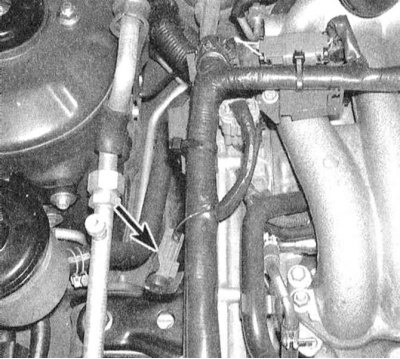- a) Check the patency of the air cleaner filter element;
- b) Check the intake air path for signs of leaks;
- c) Make sure there are no signs of loss of vacuum through the vacuum hoses;
- d) Check the condition of the battery and the correct functioning of the ignition system, including the setting of the ignition timing (see chapter Settings and ongoing maintenance);
- e) Check fuel pressure (see Section Check of serviceability of functioning of the fuel pump, measurement of pressure of fuel);
- f) Check the compression pressure in the cylinders (see part General engine overhaul Head Engine);
- g) Check the condition of the EGR and EVAP systems (see chapter Engine management systems);
- h) Check TPS adjustment (see chapter Engine management systems);
- i) Check the on-board self-diagnosis system for stored fault codes (see chapter Engine management systems).
Examination

1. Connect a manual tachometer to the engine according to the manufacturers instructions.
Note. On models since 1995, where a distributorless ignition system is used, a special connector is provided for connecting a tachometer, included in the wiring harness on the right side of the engine compartment.
2. Set the parking brake firmly and chock the rear wheels. Move the transmission to position "R" or "N". Turn off all electrical consumers. On models 1993 and 1994 issue remove the PCM access panel (see chapter Engine management systems).
3. Start the engine and warm it up to normal operating temperature. After setting the engine speed to 2000 rpm, quickly raise it three times to 3000 rpm, then let the engine idle for about a minute.
4. On 1993 and 1994 models. issue turn the mode selector on the PCM wall all the way clockwise (see chapter Engine management systems).
5. On models since 1995, no. stop the engine and disconnect the wiring from the throttle position sensor (TPS) (see chapter Engine management systems). Restart the engine and raise the engine speed three times to above 3000 rpm, finally returning to idle.
6. Read the idle speed from the tachometer and compare the measurement with the requirements of the Specifications or the data of the VECI label.
Note. In case of conflict, VECI data should prevail.
Adjustment

1. At excessively low or high idle speeds, they should be corrected using a special adjusting screw.
Attention! Do not attempt to adjust the idle speed with the factory installed set screw located on the throttle body.
2. On 1993 and 1994 models. issue turn the PCM mode selector fully counterclockwise, then stop the engine.
3. On models since 1995, no. stop the engine and connect the electrical wiring to the TPS.
4. Disconnect the tachometer.